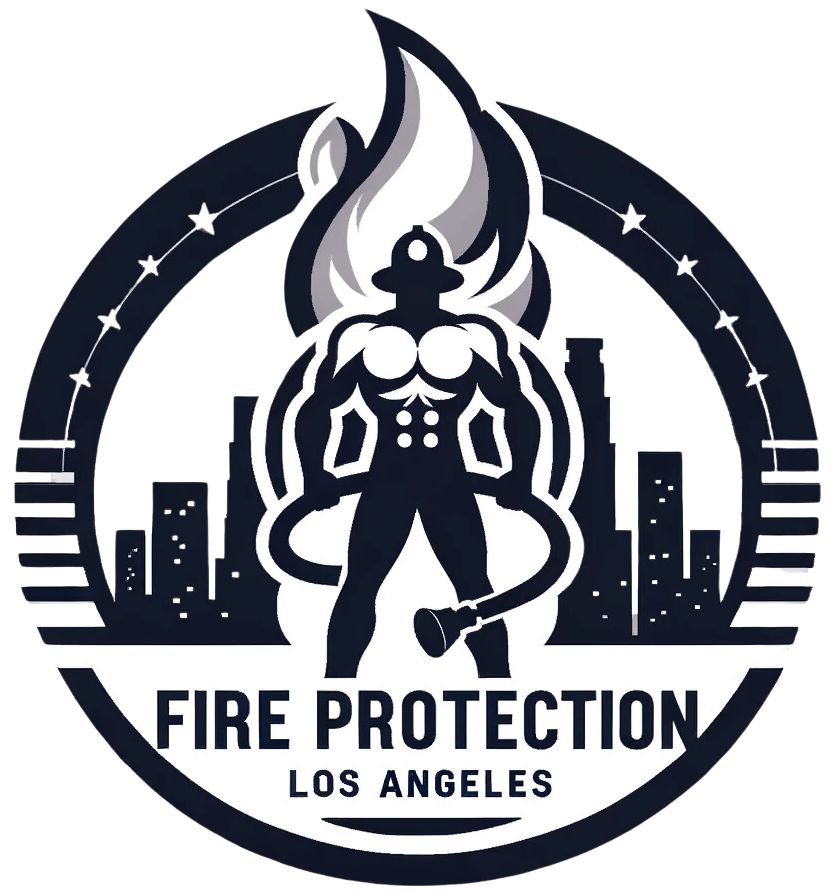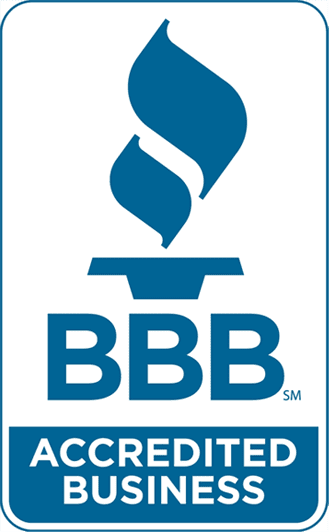To effectively mitigate fire risk, we should focus on a few key techniques. First, creating defensible space around our homes is crucial; planting strategically and clearing debris can greatly reduce fire hazards. Upgrading to nonflammable materials for roofs and siding is essential, as is regularly maintaining our properties. We must also prepare emergency plans, ensuring every family member knows their roles and evacuation routes. Engaging with our communities on wildfire protection plans keeps us informed and resilient. By applying these strategies, we enhance safety for ourselves and our neighbors. And there's more we can explore to strengthen our preparedness.
Understanding Fire Risk
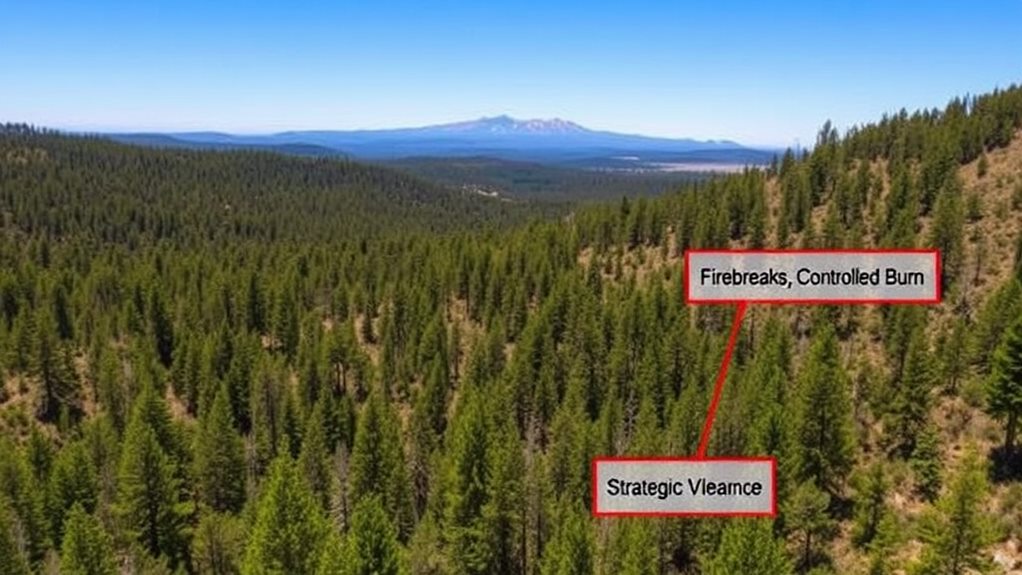
Understanding fire risk is fundamental for everyone, especially in areas prone to wildfires. Wildfires have burned an average of 7 million acres annually in the U.S. since 2000, revealing the increasing threat to our communities and ecosystems.
With over 46 million U.S. homes located in wildland-urban interface (WUI) zones, the need for awareness and preparedness is more pressing than ever. We must take personal responsibility for understanding our risk levels, as not all residents may receive evacuation orders during a wildfire.
Mitigation strategies, like creating defensible space around our homes, can markedly reduce fire risk. This involves managing vegetation and keeping flammable materials away from our properties.
Community education plays an important role in spreading awareness about wildfire prevention and the significance of emergency services. Understanding community engagement is fundamental as we should all stay informed about local fire-prone areas and the specific risks they pose.
Additionally, investing in fire prevention can save us money in the long run. FEMA estimates that for every $1 spent on prevention, $6 can be saved in firefighting costs, which highlights the financial benefits of proactive measures.
Home Upgrades for Safety
When it comes to keeping our homes safe from fire risks, choosing nonflammable materials for things like siding and roofing is a smart first step.
Additionally, establishing a defensible space around your property, free of flammable elements, greatly enhances fire safety.
We can also enhance our protection by regularly maintaining these materials and applying fire retardants where needed.
By making these upgrades, we not only reduce vulnerability but also create a safer living environment for ourselves and our loved ones.
For more information on fire-resistant building options, consider exploring fire-resistant home features.
Nonflammable Material Selection
Choosing the right materials for our homes is essential for enhancing fire safety. By selecting nonflammable materials like tile, metal, or brick for our exterior elements, we can considerably reduce fire risk. These materials don't ignite easily compared to traditional wood or vinyl siding.
Upgrading our roofs to fire-resistant materials, such as metal or asphalt, helps protect against embers, especially in wildfire-prone areas. It's important to use fire-resistant materials that provide maximum protection and guarantee a safe environment for our families.
We should also consider ember protection by installing incombustible screens on vents, chimneys, and stovepipes, which can prevent embers from entering and igniting flammable materials inside our homes.
Additionally, utilizing fire-resistant fencing materials, like metal or other non-combustible options, can create barriers that reduce the risk of fire spreading.
To further enhance fire safety, we can apply chemical fire retardants to flammable surfaces, such as wood siding, to protect our homes from fire hazards.
It's also important to maintain proper vegetation around our homes, keeping flammable vegetation clear and managing controlled burns when necessary.
Regular Maintenance Practices
Regular maintenance practices are essential for keeping our homes safe from fire hazards. By regularly clearing our roofs and gutters of debris, we reduce the risk of flammable materials igniting from flying embers. Accumulated leaves and twigs can catch fire easily, so let's stay vigilant.
Additionally, maintaining a clean and clutter-free environment can help minimize fire risks, as the importance of fire safety knowledge can't be overstated. We should also patch any gaps and cracks in our walls and siding with caulk or putty. This helps prevent embers from entering our homes and igniting combustible materials inside.
Replacing damaged deck boards with fire-resistant treated materials is another important step. Wooden decks can pose a significant fire danger if they're not properly maintained.
We can further enhance our safety by installing incombustible protective screens on vents, chimneys, and stovepipes to keep embers out. Additionally, ensuring our garage doors have fire-resistant weather stripping minimizes the risk of fire spreading to the rest of our home.
Effective Ground Clearance
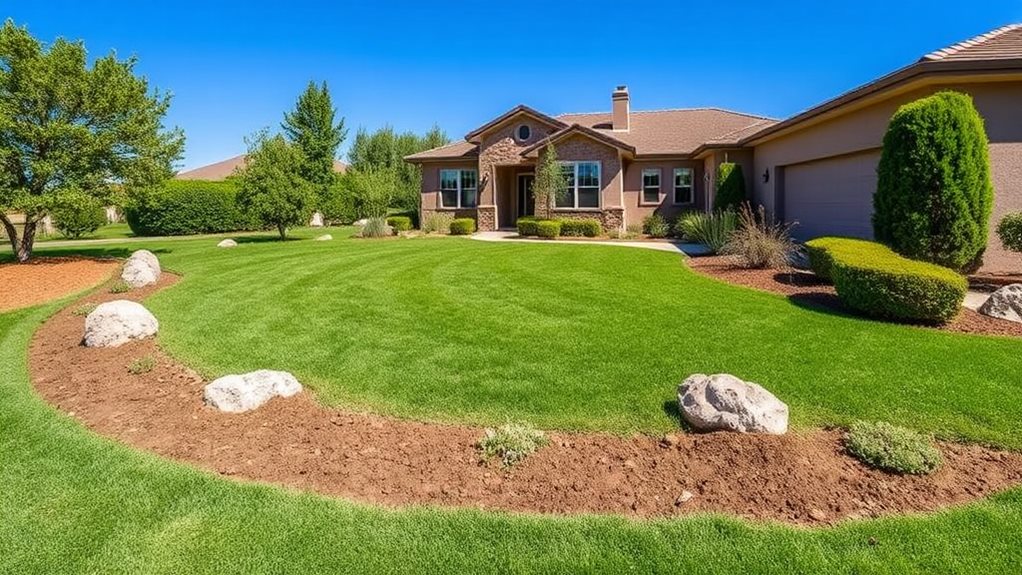
To effectively reduce fire risks around our homes, we need to focus on proper ground clearance by managing vegetation spacing and flammable items.
Establishing a defensible space around our properties is essential, as it helps to slow or stop the spread of fire. By keeping trees and shrubs at least 30 feet apart, we can prevent fires from spreading easily between them, while also ensuring that we remove any combustible objects from close proximity to our structures.
Regular maintenance, like keeping our lawns mowed and pruning tree limbs, is key to creating a safer environment for everyone.
Vegetation Spacing Guidelines
Creating a defensible space around our homes is essential for fire risk mitigation, and effective vegetation spacing plays a critical role in this effort. We should aim to maintain at least 30 feet of defensible space by removing or spacing out flammable vegetation. This helps prevent fire from reaching our property.
For instance, we need to space trees at least 10 feet apart to reduce the likelihood of fire jumping from one tree to another, which can facilitate rapid spread.
Additionally, trimming grass and weeds to a maximum height of 4 inches minimizes ground fuels and enhances our control over vegetation. It's also important to prune tree branches, ensuring they're at least 10 feet away from stovepipes and chimneys. This reduces the risk of fire igniting from embers.
To further enhance our efforts, we can create a buffer zone using non-flammable materials for landscaping within the first five feet of our homes. This helps eliminate potential ground fuels and strengthens our fire risk mitigation strategy.
Flammable Item Management
Effective ground clearance is essential for reducing fire risk around our homes. By maintaining a defensible space of at least 30 feet, we can effectively manage flammable items, like leaves, wood piles, and outdoor furniture. This clearance considerably lowers the chances of a fire spreading to our properties. During fire season, moving flammable items, such as propane tanks, away from structures is vital.
Regular maintenance, like mowing our lawns to a maximum height of 4 inches, prevents dry grass from accumulating, which can easily fuel wildfires. Additionally, pruning tree limbs to keep them at least 10 feet away from roofs and chimneys helps minimize the risk of embers igniting combustible materials nearby.
We should also create space between vegetation, ensuring there's at least a 10-foot gap between plants. This practice can stop fire from jumping between fuel sources, greatly reducing the likelihood of flames reaching our homes.
Emergency Preparedness Plans
When it comes to protecting our families from the threat of wildfires, having a solid emergency preparedness plan is essential. We need to discuss evacuation routes and responsibilities with all household members, ensuring everyone knows what to do in case of a wildfire.
Preparing go-bags with essential supplies—like masks, water, food, clothing, and first aid kits—should be a priority for each person, including our pets.
Establishing a designated meeting place helps guarantee everyone's safety if we get separated during an evacuation. This designated spot allows for effective communication, which is vital in stressful situations. We must also familiarize ourselves with utility shut-off procedures before evacuating to prevent hazards like gas leaks or electrical fires after a wildfire.
Regularly practicing our emergency plan enhances our preparedness, allowing all family members to know their roles and the necessary actions during a wildfire event.
Community Engagement Strategies
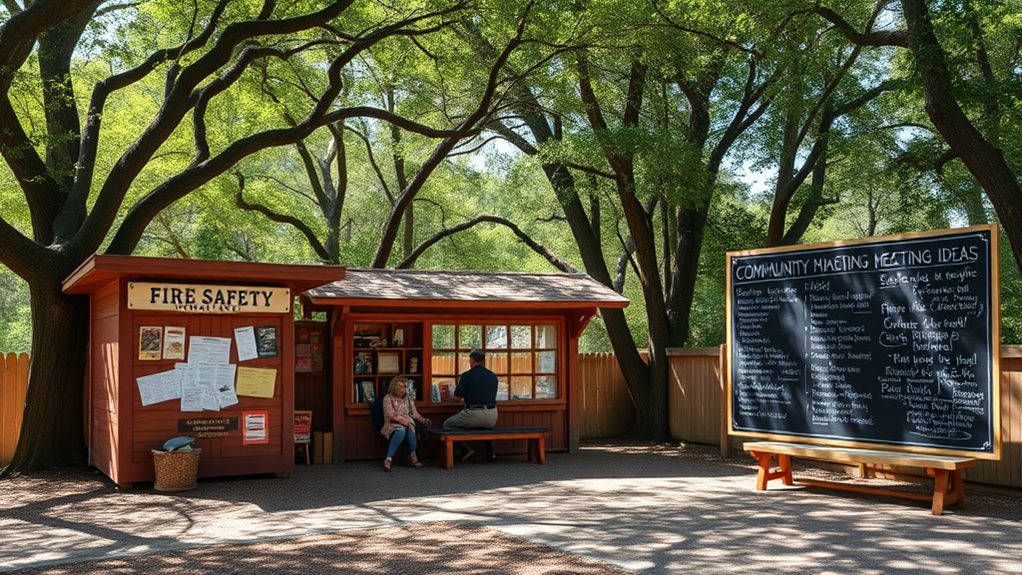
While individual preparedness is essential, engaging our entire community in fire risk mitigation can amplify our efforts. One effective way to start is by establishing a Community Wildfire Protection Plan (CWPP). This plan helps us identify specific fire risks in our area and develop strategies to address them collectively.
We can also hold neighborhood clean-up programs to remove flammable materials and debris from shared spaces, greatly reducing potential fire hazards. Collaborating with local fire departments to host educational workshops can enhance our understanding of fire risks and prevention strategies.
These workshops foster a culture of preparedness, making us more equipped to handle emergencies. Additionally, we should promote regular communication channels, like social media groups or community meetings, which keep everyone informed about fire conditions, evacuation routes, and safety resources.
Encouraging participation in controlled burning programs can also help manage vegetation and create safer buffer zones. By working together on these initiatives, we can improve our community's fire mitigation efforts and create a safer environment for everyone.
Let's commit to engaging with our neighbors and taking these practical steps to protect our homes and community from fire risks.
Specialized Fire Programs
Specialized fire programs provide crucial resources for communities looking to enhance their fire risk mitigation efforts. One key element is the Community Wildfire Protection Plans (CWPP), which help us identify and reduce wildfire risks. These plans outline strategies to promote community awareness and encourage engagement in fire prevention.
Controlled burning programs are another imperative part of our approach. They maintain ecosystems and clear excessive vegetation, which can prevent catastrophic wildfires.
Collaborating with local fire authorities, we work to establish clear evacuation routes and provide evacuation training to guarantee everyone knows what to do in an emergency.
In high-risk areas, the Wildland Urban Interface (WUI) guidelines recommend using fire-resistant materials for construction. This helps protect homes while creating a defensible space around properties.
Specialized programs often involve local organizations, focusing on fire prevention education and community clean-up initiatives to reduce potential fire hazards.
Continuous Education and Awareness
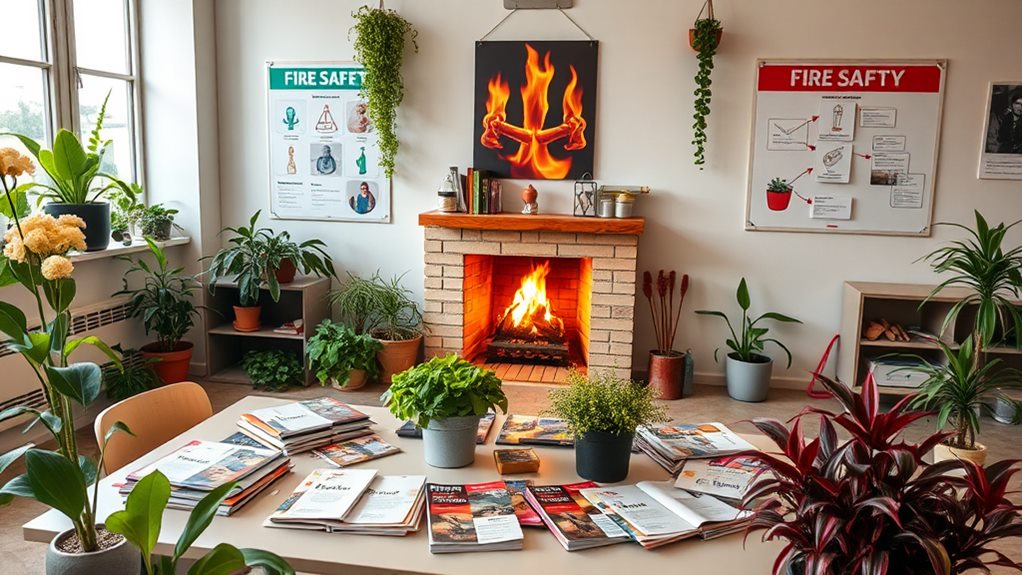
To effectively combat the rising threat of wildfires, we must prioritize continuous education and awareness within our communities. Each year, millions of acres burn, reminding us of the urgent need to understand wildfire risks. By engaging in public workshops and training sessions, we can empower ourselves with knowledge about fire prevention and preparedness, which fosters community resilience.
Collaborating with local fire departments and emergency management agencies is essential. They can provide valuable information about evacuation routes and effective fire risk reduction techniques. We should also utilize social media and local news outlets to share real-time fire alerts and safety information, improving community awareness during wildfire events.
Moreover, regularly evaluating and updating our community wildfire protection plans keeps us informed about evolving fire risks. This guarantees we remain prepared and ready to act when necessary.
By prioritizing continuous education, we not only enhance our understanding of wildfires but also strengthen our collective ability to respond effectively. Together, we can become proactive stewards of our environment, ensuring our communities are safer and more resilient against the threat of wildfires.
Let's commit to learning and sharing knowledge for a brighter, wildfire-ready future!
Final Thoughts
To sum up, mitigating fire risk is like building a strong fence around a garden; it protects what we cherish. By understanding fire risks, making home upgrades, and preparing emergency plans, we can safeguard our families and communities. Engaging with neighbors and staying informed through continuous education helps us create a safer environment. Let's commit to these strategies, ensuring that we're ready for any challenges that may arise, and together, we can make a difference for everyone.
